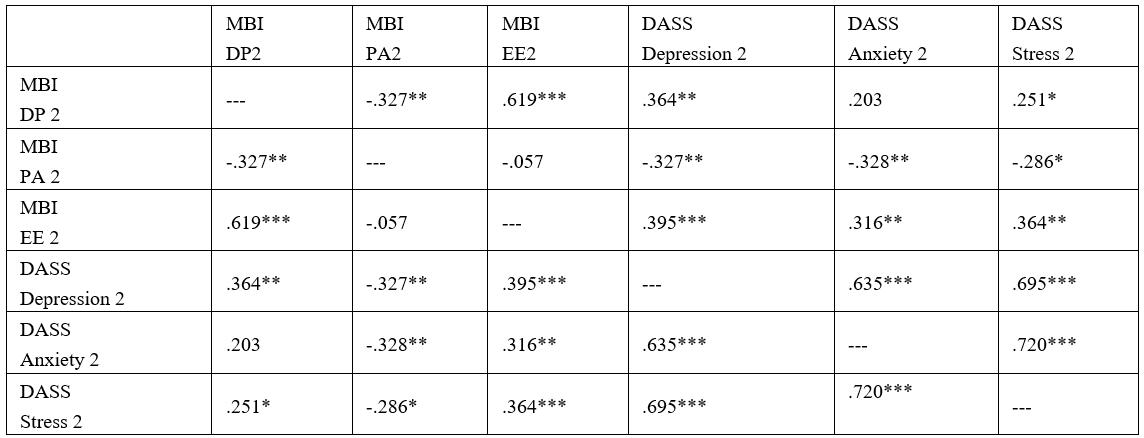Targeting Burnout and Emotional State in Nurses within a Mental Health Care Setting: A Quasi-Experimental Study
Abstract
Nurse burnout is a widespread phenomenon that may impact their quality of life, work efficacy and organisational commitment. Hence, the need for interventions that enhance nurse well-being, and which target the needs and concerns of professionals working in a complex and dynamic context. The aim of this study is to examine the effectiveness of an intensive intervention for nurses providing care to persons with mental illnesses. A quasi-experimental study was conducted with 120 nurses. Sixty-eight nurses received the intervention, and fifty- two nurses were in the control group. The intervention incorporated sessions on: (i) critical and creative thinking; (ii) mindfulness; (iii) legal issues; (iv) documentation and (v) expressive arts. Participants completed the Maslach Burnout Inventory and the DASS-21 at pre- and post- test. The single day intervention was repeated for 4 consecutive times. Data were analysed using the Pearson’s chi square test, Wilcoxon sign test, Mann–Whitney U test, Spearman’s rank order correlation and a general linear model. Significant decreases in burnout-depersonalisation, stress and anxiety were identified post intervention. Stress, personal accomplishment (burnout), gender and age-group were predictors of the burnout domain- depersonalisation. Interventions incorporating critical and creative thinking and legal issues in addition to cognitive and expressive art sessions, are efficacious in reducing burnout, anxiety, and stress in nurses.
References
Bartosiewicz, A., & Januszewicz, P. (2019). Readiness of polish Nurses for prescribing and the level of professional burnout. International Journal of Environmental Research and Public Health, 16(1), 35. https://doi.org/10.3390/ijerph16010035
Bjerkan J, Valderaune V and Olsen RM (2021) Patient Safety Through Nursing Documentation: Barriers Identified by Healthcare Professionals and Students. Frontiers in Computer Science. 3:624555. https://doi.org/10.3389/fcomp.2021.62455
Brown, T. A., Chorpita, B. F., Korotitsch, W., & Barlow, D. H. (1997). Psychometric properties of the Depression Anxiety Stress Scales (DASS) in clinical samples. Behaviour research and therapy, 35(1), 79-89. https://doi.org/10.1016/s0005-7967(96)00068-x
Cheraghi, M. A., Pashaeypoor, S., Dehkordi, L. M., & Khoshkesht, S. (2021). Creativity in Nursing Care: A Concept Analysis. Florence Nightingale Journal of Nursing, 29(3), 389. https://doi.org/10.5152%2FFNJN.2021.21027
Cottrell, S. (2017). Critical thinking skills: Effective analysis, argument and reflection. Bloomsbury Publishing.
De Clercq, D., Haq, I. U., & Azeem, M. U. (2020). The relationship between workplace incivility and depersonalization towards co-workers: Roles of job-related anxiety, gender, and education. Journal of Management & Organization, 26(2), 219-240. https://doi.org/10.1017/jmo.2019.76
Demerouti, E., Bakker, A. B., Vardakou, I., & Kantas, A. (2003). The convergent validity of two burnout instruments: A multitrait-multimethod analysis. European Journal of Psychological Assessment, 19(1), 12. https://doi.org/10.1027/1015-5759.19.1.12
Dreison, K. C., Luther, L., Bonfils, K. A., Sliter, M. T., McGrew, J. H., & Salyers, M. P. (2018). Job burnout in mental health providers: A meta-analysis of 35 years of intervention research. Journal of occupational health psychology, 23(1), 18. https://doi.org/10.1037/ocp0000047
Faul, F., Erdfelder, E., Lang, A. G., & Buchner, A. (2007). G* Power 3: A flexible statistical power analysis program for the social, behavioral, and biomedical sciences. Behavior research methods, 39(2), 175-191. https://doi.org/10.3758/bf03193146
Henry, J. D., & Crawford, J. R. (2005). The short‐form version of the Depression Anxiety Stress Scales (DASS‐21): Construct validity and normative data in a large non‐clinical sample. British Journal of Clinical psychology, 44(2), 227-239. https://doi.org/10.1348/014466505X29657.
Johnson, J., Hall, L. H., Berzins, K., Baker, J., Melling, K., & Thompson, C. (2018). Mental healthcare staff well‐being and burnout: A narrative review of trends, causes, implications, and recommendations for future interventions. International Journal of Mental Health Nursing, 27(1), 20-32. https://doi.org/10.1111/inm.12416
Kataoka-Yahiro, M., & Saylor, C. (1994). A critical thinking model for nursing judgment. Journal of Nursing Education, 33(8), 351-356. https://doi.org/10.3928/0148-4834-19941001-06
Khatatbeh, H., Pakai, A., Al‐Dwaikat, T., Onchonga, D., Amer, F., Prémusz, V., & Oláh, A. (2022). Nurses’ burnout and quality of life: A systematic review and critical analysis of measures used. Nursing Open, 9(3), 1564-1574. https://doi.org/10.1002/nop2.936
Li, Y., Wu, Q., Li, Y., Chen, L., & Wang, X. (2019). Relationships among psychological capital, creative tendency, and job burnout among Chinese nurses. Journal of Advanced Nursing, 75(12), 3495-3503. https://doi.org/10.1111/jan.14141
Liu, Y., & Aungsuroch, Y. (2019). Work stress, perceived social support, self‐efficacy and burnout among Chinese registered nurses. Journal of nursing management, 27(7), 1445-1453. https://doi.org/10.1111/jonm.12828
López‐López, I. M., Gómez‐Urquiza, J. L., Cañadas, G. R., De la Fuente, E. I., Albendín‐García, L., & Cañadas‐De la Fuente, G. A. (2019). Prevalence of burnout in mental health nurses and related factors: a systematic review and meta‐analysis. International Journal of Mental Health Nursing, 28(5), 1035-1044. https://doi.org/10.1111/inm.12606
Lovibond, P. F., & Lovibond, S. H. (1995). The structure of negative emotional states: Comparison of the Depression Anxiety Stress Scales (DASS) with the Beck Depression and Anxiety Inventories. Behaviour research and therapy, 33(3), 335-343. https://doi.org/10.1016/0005-7967(94)00075-U
Ma, X., Yang, Y., Wang, X., & Zang, Y. (2018). An integrative review: Developing and measuring creativity in nursing. Nurse Education Today, 62, 1-8. https://doi.org/10.1016/j.nedt.2017.12.011
Maslach, C., Jackson, S. E., & Leiter, M. P. (1996). MBI: Maslach burnout inventory: CPP, incorporated Sunnyvale (CA).
Moalemi, S., Kavosi, Z., Beygi, N., Deghan, A., Karimi, A., & Parvizi1, M. M. (2018). Evaluation of the Persian Version of Maslach Burnout Inventory-Human Services Survey among Iranian Nurses: Validity and Reliability. Galen Medical Journal, 7: e995. https://doi.org/10.22086%2Fgmj.v0i0.995
Mednick, S. (1962). The associative basis of the creative process. Psychological review, 69(3), 220. https://doi.org/10.1037/h0048850
Morrissey, J., & Higgins, A. (2019). “Attenuating Anxieties”: A grounded theory study of mental health nurses’ responses to clients with suicidal behaviour. Journal of Clinical Nursing, 28(5-6), 947-958. https://doi.org/10.1111/jocn.14717
Ohue, T., Aryamuang, S., Bourdeanu, L., Church, J. N., Hassan, H., Kownaklai, J., ... Suwannimitr, A. (2021). Cross‐national comparison of factors related to stressors, burnout and turnover among nurses in developed and developing countries. Nursing open, 8(5), 2439-2451. https://doi.org/10.1002/nop2.1002
Ortega, E., Cañadas-De la Fuente, G. A., Ramirez-Baena, L., De la Fuente-Solana, E. I., Vargas, C., & Gómez-Urquiza, J. L. (2018). Gender, marital status, and children as risk factors for burnout in nurses: A meta-analytic study. International Journal of Environmental Research and Public Health, 15(10), 2102. https://doi.org/10.3390/ijerph15102102
Partnership for 21st Century Learning (2015). P21 framework definitions. www.p21.org/our-work/p21-framework
Phillips, C. S., & Becker, H. (2019). Systematic Review: Expressive arts interventions to address psychosocial stress in healthcare workers. Journal of Advanced Nursing, 75(11), 2285-2298. https://doi.org/10.1111/jan.14043
Ruiz-Íñiguez, R., Pérez-Díaz, R., García-Jacomino, J. C., Carralero-Montero, A., & Santed, M. Á. (2021). Acceptability and effectiveness of a mindfulness-based intervention for reducing stress and burnout among mental health professionals: A mixed-methods pilot study conducted in Cuba. Current Psychology, 1-12. https://doi.org/10.1007/s12144-021-01388-1
Salvado, M., Marques, D. L., Pires, I. M., & Silva, N. M. (2021, October). Mindfulness-Based Interventions to Reduce Burnout in Primary Healthcare Professionals: A Systematic Review and Meta-Analysis. In Healthcare (Vol. 9, No. 10, p. 1342). MDPI. https://doi.org/10.3390/healthcare9101342
Shenai, N. A., Joseph, J., & Kachappillil, A. J. (2019). Knowledge of staff nurses regarding legal aspects of patient care. Asian Journal of Nursing Education and Research, 9(1), 143-145. https://doi.org/10.5958/2349-2996.2019.00029.6
Suleiman‐Martos, N., Gomez‐Urquiza, J. L., Aguayo‐Estremera, R., Cañadas‐De La Fuente, G. A., De La Fuente‐Solana, E. I., & Albendín‐García, L. (2020). The effect of mindfulness training on burnout syndrome in nursing: a systematic review and meta‐analysis. Journal of Advanced Nursing, 76(5), 1124-1140. https://doi.org/10.1111/jan.14318
Xavier, K. F., Mmusi-Phetoe, R., & Thupayagale-Tshweneagae, G. (2019). Nurses' Perception of Ethics and Legal Training of Nurses in Ghana. International Journal of Nursing Education, 11(4). https://doi.org/10.5958/0974-9357.2019.00117.X
Xie, Z., Wang, A., & Chen, B. (2011). Nurse burnout and its association with occupational stress in a cross‐sectional study in Shanghai. Journal of Advanced nursing, 67(7), 1537-1546. https://doi.org/10.1111/j.1365-2648.2010.05576.x
Zeng, L. N., Zhang, J. W., Zong, Q. Q., Chan, S. W. C., Browne, G., Ungvari, G. S., ... Xiang, Y. T. (2020). Prevalence of burnout in mental health nurses in China: A meta-analysis of observational studies. Archives of Psychiatric Nursing, 34(3), 141-148. https://doi.org/10.1016/j.apnu.2020.03.006


This work is licensed under a Creative Commons Attribution 4.0 International License.
Copyright for this article is retained by the author(s), with first publication rights granted to the journal.
This is an open-access article distributed under the terms and conditions of the Creative Commons Attribution license (http://creativecommons.org/licenses/by/4.0/).









1.png)














